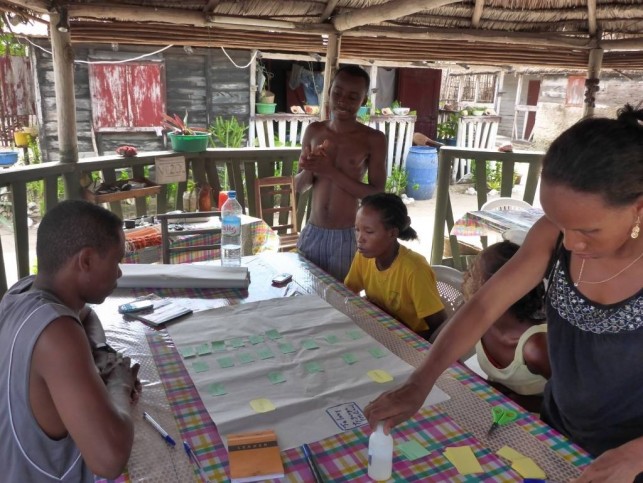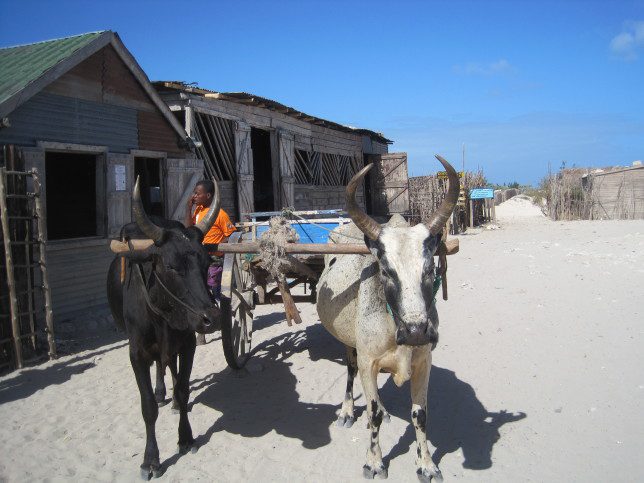By Cicelin Rakotomahazo, blue forests socioeconomic scientist, Madagascar
A few months ago, the blue forests team set out to facilitate a “Theory of Change” exercise with communities from nine villages in the Bay of Assassins, in the Velondriake locally managed marine area in southwest Madagascar.
The Bay of Assassins is known as the lungs of Velondriake’s conservation activities, thanks to its diverse range of marine habitats including shallow reef flats, beautiful mangrove forests and seagrass beds. It’s consequently home to the majority of Velondriake’s sea cucumber and seaweed farming projects. It’s located about six hours 4×4 drive north of Toliara (the regional capital), and about one hour south of Andavadoaka, BV’s primary field site in southwest Madagascar.
What is a “Theory of Change” (ToC? As the socioeconomic scientist for the blue forests team, I’m now able to answer that question! After several months of reviewing literature and discussing with my colleagues, I would now define it as a description of a sequence of events that is expected to lead to a particular desired outcome. ToC has been used for more than 20 years across multiple disciplines, but has recently been adapted by RARE to better link social change to biodiversity threat reduction.
In our context, it has been used to articulate how shifting behaviours and social norms could reduce threats to mangrove and wild sea cucumber resources in the Bay of Assassins. Why are we focusing on these two resources? Because the local management committees have ranked them as their most important assets.

Dolce, Cicelin, CBFs and Lalao working mangrove and sea cucumber concept model development in the village of Tampolove
So in an effort to understand the local context in the Bay of Assassins, we aimed to develop concept models with the communities for both mangrove and wild sea cucumber resources. This was to help us understand the perceived state of those resources (declining, stable or increasing), direct threats to them, underlying causes of threats and the possible solutions that could be implemented to reduce these threats. Finally, barriers to achieving the solutions were also identified for each resource, in order to better understand what effective and sustainable strategies could be used to manage resources without resulting in significant loss for the community.
And so began our journey to the village of Tampolove, located at the heart of the Bay of Assassins, enduring the muddy, sandy, bumpy and somewhat flooded road for six hours from Toliara. Once in Tampolove, we had planned two days of preparation and training sessions with two Community-Based Facilitators (CBFs) who were both from this village and hired to help us with the field mission.
Our initial training session with the CBFs consisted of explaining the objectives and methods of the ToC exercise, and producing mind maps with our different ideas, using small bits of different coloured paper. During the first session, the CBFs were acting as community members, giving us their ideas on what might be identified as threats and solutions during the rest of our sessions.
Then we divided up the tasks. One person would deal with writing the ideas onto the coloured paper (different colours were applied for each type of question: state, threats, causes, solutions and barriers), one person would arrange these ideas on the big poster paper using masking tape, and one person would be in charge of animating and encouraging the communities to give their ideas. After developing different practice concept models for both sea cucumbers and mangroves, the team swapped roles, allowing everyone to practice facilitating sessions.
By the end of the two training days we were all ready to conduct these participatory ToC sessions with communities in the Bay of Assassins. The sessions started in the village of Tampolove, held in their large seaweed storage room (Tampolove is one of the leading aquaculture villages in the Bay of Assassins), with an impressive number of men and women in attendance. The participants were divided into two groups according to their occupations (ie. sea cucumber fishers or mangrove wood collectors), to complete both sea cucumber and mangrove concept models. This village was very animated and got quickly involved in the sessions, creating two very interesting concept models by the end.
Aside from our various adventures travelling both inland and at sea, where we used all means of transport including zebu carts, pirogues, 4x4s and walking on foot (almost everything except a plane!) to reach the remaining eight villages, we also experienced challenges during the sessions themselves when trying to engage communities, as sometimes people were not forthcoming with ideas or were nervous to voice their opinions.
That is why the role of the blue forests team in animating people to express their ideas for sea cucumber and mangrove management was so important, as they were required to pose leading questions periodically, and sometimes even propose ideas to help generate further discussion around a topic. Conversely, in some cases, we noticed a huge involvement from communities and from of women especially in the villages of Vatoavo, Ankitambagna, Lamboara and Befandefa.

Grouping ideas in the village of Befandefa
Overall, overexploitation was identified as the primary direct threat to both resources in the Bay of Assassins, caused by population growth (due partly to high migration levels), poverty, lack of livelihood alternatives, lack of management and habitat degradation caused by natural disasters (cyclones) and more specifically by a destructive sea cucumber fishing technique called Vali-bato (the upturning of rocks and coral reef to find sea cucumbers).
Suggested solutions included increased access to family planning, education and awareness raising, promotion of alternative livelihoods (seaweed, vegetable, sea cucumber and chicken farming), mangrove and sea cucumber temporary and permanent reserves alongside mangrove planting and dina development and enforcement.
Barriers to achieving those solutions included a high dependence on marine-based activities, worries about maintaining the famous Malagasy fihavanana (friendship) when enforcing their community law (dina), and lack of money, materials, technical knowledge and access to markets to diversify livelihoods.
I personally feel that the whole process in the field went well, thanks to the hard work and solidarity of the team. This process allowed me to see how ToC can be used to understand natural resource use, and work towards sustainable management. This was the first of many steps in the ToC process to identify the series of events which could lead to behaviour change to achieve sustainable management of resources in the Bay of Assassins, with much more hard work and critical thinking to follow now that we have a more detailed idea of the context that we’re working in.
Our concept models highlighted a list of potential strategies that could be used to manage the Bay of Assassin’s wild sea cucumber populations and mangrove stands. Our next step will be to enter all the data gathered and build one overarching concept model for each of those resources. Another trip to each village will be planned soon to develop these ideas further in a participatory manner, and assess the motivation and capacity for achieving the solutions suggested to manage their resources.

Everything but a plane! Zebu carts are the traditional way of getting around on land in Madagascar
Overall, this exercise has helped to get people thinking more critically about sustainable management of natural resources and how this can be feasibly achieved, by identifying attainable solutions and the hurdles over which we must climb in order to achieve them.
All of this information gives us a good platform from which to continue working and building relations with the communities in the Bay of Assassins, allowing us to work as a team and provide technical support for the development and implementation of their proposed management plans where we can. Together Everyone Achieves More (TEAM)! As one community member said: “The sea is our life. So, with transparent participatory management of our resources, the future of our descendants will be assured“.

